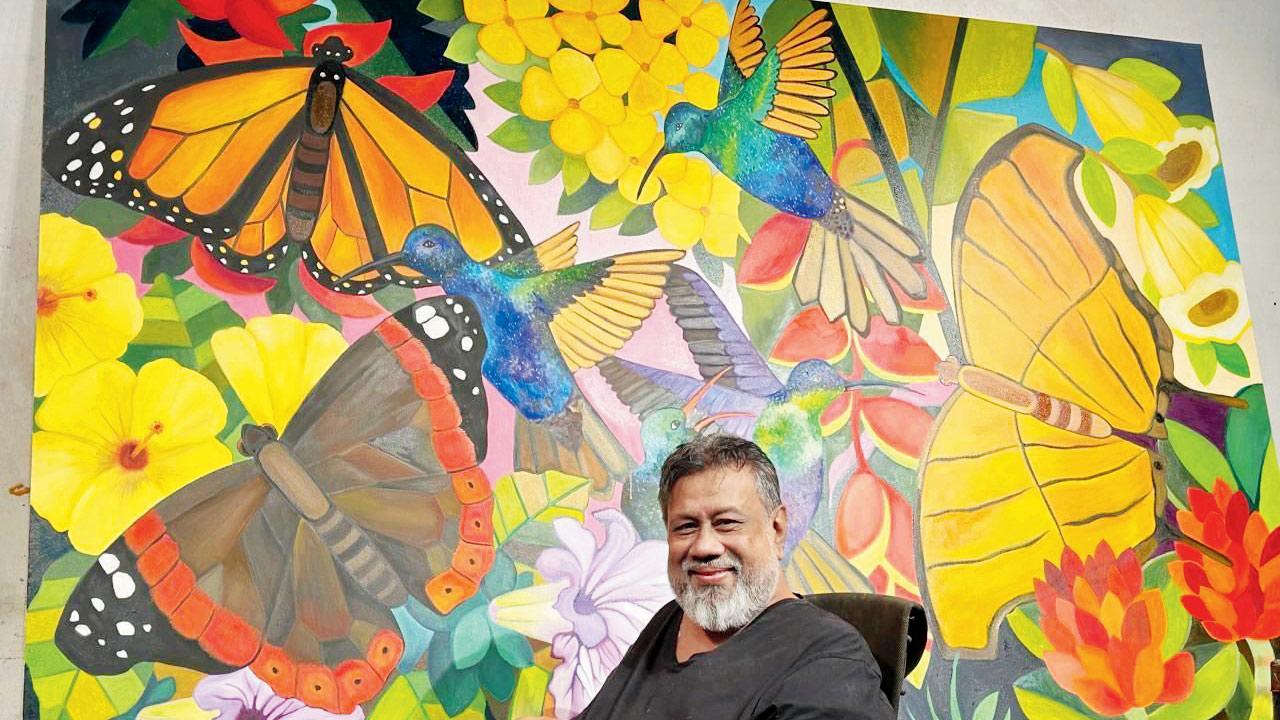Hailing from a family of Prime Ministers, Senaka Senanayake’s vast canvas shines a light on his deep-rooted love for the island’s fragile environment and its natural resources

Senaka Senanayake in the foreground of his canvas
Throughout its history, Sri Lanka has been scarred by civil war and infighting. In 2022, the country reached the brink of bankruptcy, causing mass panic. The concerns of art, nature and aesthetics feel superficial at such times. Yet, for 73-year old Senaka Senanayake, it is art that can best capture the beauty and complexity of Sri Lanka.
ADVERTISEMENT

The banana grove triptych, oil on canvas
“People often forget that like India, Sri Lanka too emerged from the aftermath of colonialism,” Senanayake points out. The artist points to the fading Sri Lankan rainforests as the proof of the pudding. “The island boasts of a tropical rainforest hotspot with over 60 percent endemic species that cannot be found anywhere else in the world. It is a UNESCO World Heritage Site,” remarks Senanayake, who spent the last three years in the Sinharaja Reserve in the Galle district. Elephants aside, rare species of butterflies, orchids, the toque macaque, Sri Lankan leopards, woodpeckers dot these forests, he notes. Yet, these rare resources are ignored.
It is no surprise then that the greenery from the emerald isle inspires his latest exhibition in the city. Twenty-five pieces of oil paintings, alongside sketches and watercolours, emerged from his exhaustive efforts of conservation and documentation of Sri Lankan wildlife, and are currently on display at the Snowball Studios in Worli. “The idea was to bring these visuals to awaken a new generation of Sri Lankans to the treasures at home,” he says.

Untitled (Monks 3)
Art is the only way I can speak, says Senanayake. If the surname seems familiar it is only because he hails from a family that produced two former Prime Ministers of the country, including DS Senanayake — the first Prime Minister of independent Sri Lanka — and later Dudley Senanayake, along with several members of parliament. “I took to art,” he laughs. Emerging as a prodigy as an eight-year-old, he went on to study in Yale and later, Cambridge. “My parents wanted me to become a doctor or a lawyer. I had no interest in either. The next best thing that offered some scope for creativity was architecture,” he shares.
This education in architecture, and the travels overseas, inculcated a keen love for the natural resources at home. “I could see that these landscapes and species do not exist anywhere else. And this is a scientific fact,” he tells us. The artist turns to an ancient Indian connection, “There is a legend that says Ravana once carried a mountain from the Himalayas down to Sri Lanka, along with the trees, flowers and animals. Perhaps, there is a kernel of truth to it,” Senanayake laughs.

In Search of The Purple Orchid
Through his canvas, these species return. The bright colours, the soft pastels and an optimistic portrayal is his way of conveying hope. “The landscape is constantly changing. For me, the canvas is a way to remind people of what they are losing. I have seen the Asian elephant move away from the highlands to the low areas where they come into conflict with people,” he says.
As he has travelled with the exhibition, Senanayake notes the commonality of the problem. “I began on this series as a Sri Lankan artist. But I can see a resonance in Mumbai, the Sunderbans, and even the Himalayas. It is an issue that raises questions on our next step as a human society,” he concludes.
TILL November 16; 11 am to 7 pm
AT Snowball Studios, Mohatta Bhavan, Dr E Moses Road, Worli.
Also Read: Souza, Sherpa and symbolism
 Subscribe today by clicking the link and stay updated with the latest news!" Click here!
Subscribe today by clicking the link and stay updated with the latest news!" Click here!







